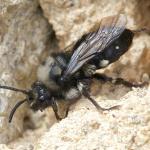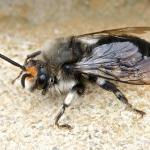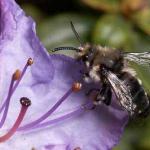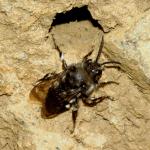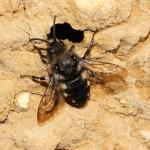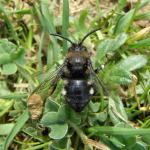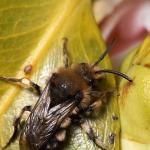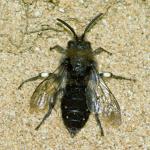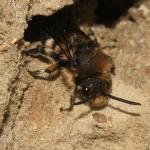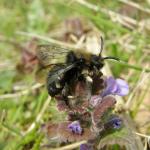Melecta punctata (FABRICIUS 1775); Melecta armata PANZER 1799; Melecta gigantea FRIESE 1925; Melecta grandis PÉREZ 1883; Melecta pseudoarmata RADOSZKOWSKI 1893; Melecta mediterranea GRIBODO; Melecta novellai DUSMET 1915; Melecta minima FRIESE 1925; Melecta fasciculata SPINOLA 1806; Crocisa atra JURINE 1806; Melecta bipunctata LEPELETIER 1841; Melecta aterrima LEPELETIER 1841; Melecta calabrina RADOSZKOWSKI 1876
An unmistakable spring bee, with the head and body entirely black except for a pair of lateral patches of white appressed hairs on most of the gastral tergites. However, in some individuals, these patches are also black, so that the bee is entirely melanic.
Throughout much of southern England, with an apparent bias towards the south-east. There is at least one old record for south Wales. It is also found in the Channel Islands (Guernsey and Jersey). The species is widely distributed in Eurasia, from Britain south to Iberia and North Africa (Morocco to Egypt), and eastwards to the Middle East, Armenia and Iran.
This species is not regarded as being scarce or threatened.
The bee can be expected to occur in the same sites as its two Anthophora host species, including coastal localities (especially soft rock cliffs) and private gardens (sometimes in large cities, including London). Usually it is rather scarce.
Univoltine; April to early June.
Apple (Malus), cabbage (Brassica sp.), cherry (Prunus sp.), ground-ivy (Glechoma hederacea), kidney vetch (Anthyllis vulneraria), rosemary (Rosmarinus officinalis), wallflower (Cheiranthus) (and some other Brassicaceae).
None recorded.
Proofed: December 2011


